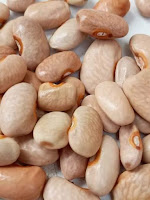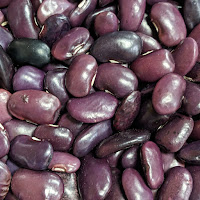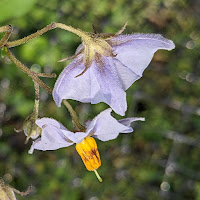 My ongoing project to produce distinctly blue dry beans occasionally throws a surprise at me. This spring, two plants with bright red flowers appeared in one of my gardens. The blue lines had until now showed a mix of white and pale pink flowers, so this change was rather dramatic.
My ongoing project to produce distinctly blue dry beans occasionally throws a surprise at me. This spring, two plants with bright red flowers appeared in one of my gardens. The blue lines had until now showed a mix of white and pale pink flowers, so this change was rather dramatic.
I immediately began thinking about how these plants came to be. They clearly grew from blue seeds I'd planted, but that was all I knew initially. Last year I had some (more or less) intentional hybrids turn up in my blue bush bean patch, so I thought they might have represented back crosses to the parental blue line.
In another garden this year is filled with an F2 population from that intentional hybrid I mentioned. If the red flower color came from a back cross, then the same color should also turn up among the F2 plants. Only white and pale pink flowers were evident when they started blooming, thus the red flower did not come from a back cross.
I did have one red-flowered Phaseolus coccineus (var "Insuk's Wang Kong") growing last year. The seed germinated late and the vine never prospered. It had only one small flower cluster and produced a single pod with a single seed. It was also on the far end of the garden from the blue bush population, with rows of large tomato and other bean plants in between. I didn't expect there would be any chance for pollen transfer like this, even though I was hoping there might be some crosses with more nearby plants because I'd been wanting to work with a P. vulgaris x P. coccineus hybrid for years.
I was eagerly waiting for the first seed pods from the red flowered plants to mature, as their seed color would likely be the definitive evidence for the plants being hybrids. The first pods broke open to reveal tan seeds marked with dark blue. The speckled trait came from the P. coccineus parent and the blue color came from the P. vulgaris parent (the blue seeds here for comparison purposes).
Hybrids between P. vulgaris and P. coccinues are often described as having growth issues or have poor seed-set, though the literature and experience of others seems to be quite variable. Fortunately, my hybrids show no such issues but perhaps they may show up in the next generations.
Because the P. coccineus parent's seeds were a pale purple, I was expecting the hybrid to turn up with a distinctly purple color and I wouldn't see the blue again until the next generation. Since the speckled trait seems to be dominant, I would expect 75% of the next generation to also show speckles. I can't really predict what the colors in the next generation will be, since I don't have a good idea of what the mixed up genetics will do.
I have read from a few references that the P. coccineus chromosomes are preferentially lost vs the P. vulgaris chromosomes in subsequent generations, so any predictable genetics ratios are likely to be distorted significantly. I'll just have to find out. Because of this tendency, similar crosses have been used before to introgress traits into P. vulgaris, such as disease resistance factors. I'm hoping I can stabilize the flower color over the next few years, as well as the tendency to bloom very well.
References:
- Interspecific hybridization between cultivated american species of the genus Phaseolus.
- Embryo development in reciprocal cross of Phaseolus vulgaris L. and P. coccineus Lam.






















